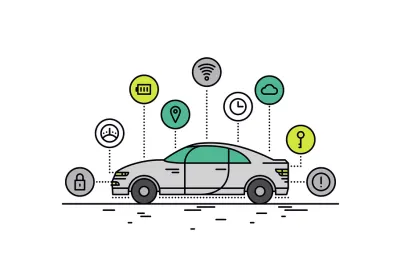The pace of innovation in the electric, autonomous, and connected vehicle space is staggering. These innovations relate to advanced sensors, radar and LiDAR, geolocation, artificial intelligence algorithms, telecommunications, and the software used to integrate all these components and collect and process the data to enable new or improved vehicular functionality. Supported by copious investments from around the world, companies are racing to bring these new technologies to market ahead of their competitors. To protect against late entrants adopting their technology and allow investors to hedge their risk, companies use patents to create barriers to entry, generate revenue streams, or otherwise provide leverage, filing 25K+ such patents in 2018. (Patent Trends Study Part Five: Automotive Industry.)
However, not all innovations may be eligible for patent protection. As discussed in the 2014 Supreme Court case Alice Corp. v. CLS Bank International, 573 U.S. 208 (“Alice”), inventions that are directed to abstract ideas or mathematical algorithms, so called “judicial exceptions,” may be ineligible for receiving patent protection. This may impact certain software implemented inventions related to artificial intelligence (“AI”) or Internet of Vehicles (“IoV”) technologies, and may even discourage companies from pursuing patent protection for such inventions. For example, since 2014, the number of patent applications filed annually for AI inventions in Digital Marketing, FinTech, Education, and Entertainment actually declined significantly. (Industry-Focused Patenting Trends, page 16.)
While the patent eligibility framework established by the Supreme Court in Alice left much uncertainty about what exactly is eligible for patent protection, subsequent opinions issued by the U.S. Court of Appeals for the Federal Circuit (“CAFC”) provide a roadmap for patent eligibility. The CAFC stated that “[s]oftware can make non-abstract improvements to computer technology just as hardware improvements can.” (Enfish, LLC v. Microsoft Corp., 822 F.3d 1327 (Fed. Cir. 2016). The CAFC further emphasized in MCRO, Inc. v. Bandai Namco Games America, decided September 13, 2016, (“MCRO”) that inventions may be eligible for patenting when “it is the incorporation of ... claimed rules, not the use of the computer, that improve the existing technological process by allowing the automation of further tasks.” The U.S. Patent and Trademark Office recently provided new guidance stating that a claim directed to a practical application of a judicial exception, such as providing an improvement to the functioning of a computer or another technology, is eligible for patent protection. (Revised Patent Subject Matter Eligibility Guidance issued by the U.S. Patent and Trademark Office on January 7, 2019.)
Most vehicular AI or IoV inventions likely provide an improvement to computer technology, an improvement to an existing technological process, or a practical application that improves the functioning of a computer or other technology and may, therefore be eligible for patent protection. However, patents may not be used to protect data compilations, such as AI training sets, or a programmer’s particular expression of source code. Even if the AI or IoV invention is eligible for patent protection, it can be challenging to accurately and precisely describe the methods or functions of an iterative/incremental machine learning process in a manner that satisfies the patent law requirements and also has a sufficiently broad scope of protection that companies can leverage for business purposes. As such, certain under-the-hood aspects of an AI or IoV innovation may be kept as a trade secret or protected via copyright, while other front-facing or easily reverse-engineerable aspects may be patented.
Congress has not stayed silent either. A new bipartisan bill impacting patent eligibility was proposed on May 22, 2019 that aims to remove the judicial exceptions and many of the various tests created by the Supreme Court and the CAFC. The proposed bill includes text explicitly abrogating or rendering invalid past case law interpreting exceptions to patenting eligibility. The bill has not been finalized, and the Senate Judiciary IP Subcommittee held hearings in early June to discuss the impact of the proposed legislation and potential changes.
To continue building valuable intellectual property assets as was done for vehicular hardware or manufacturing processes, companies will revise their IP strategies based on recent patent case law and in view of the proposed changes to the patent statutes to determine how to protect software-based inventions that enable new or improved IoV functionality or other vehicular functionality using AI.




 />i
/>i

